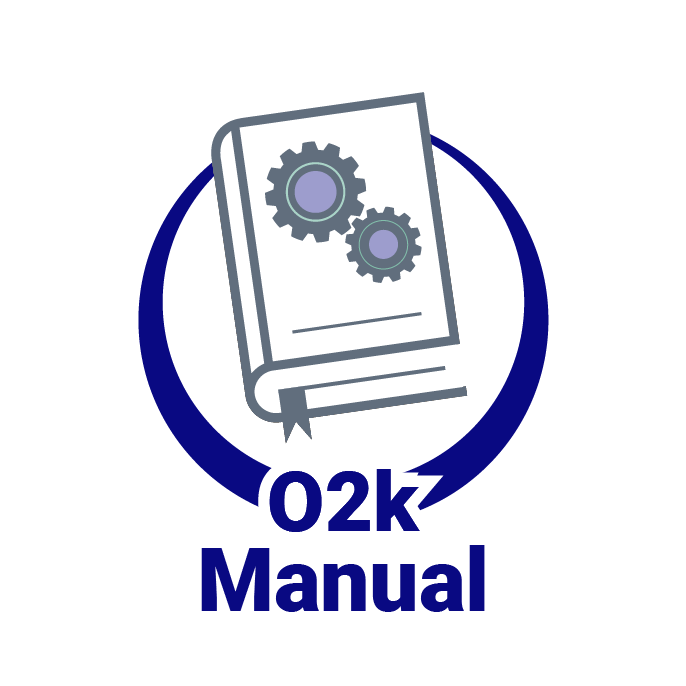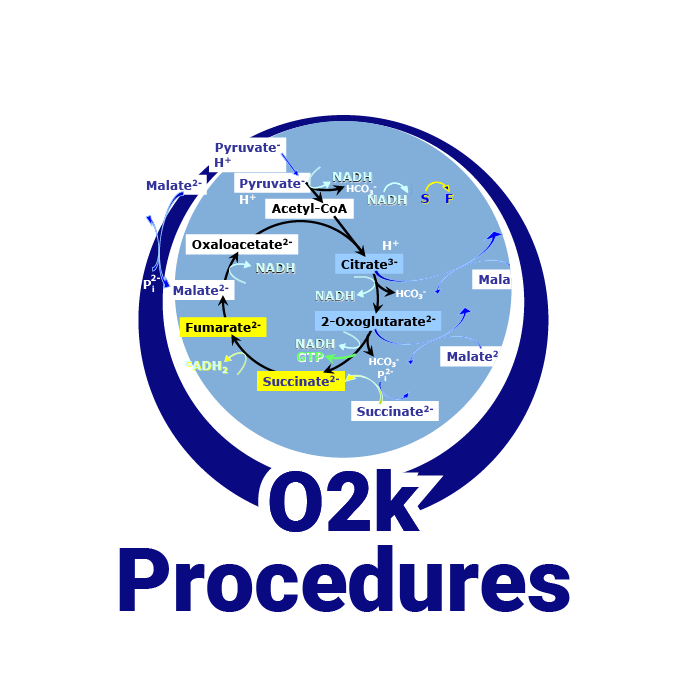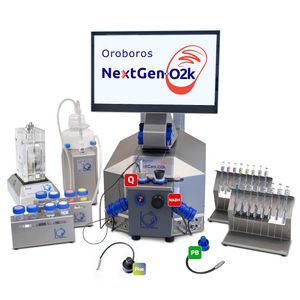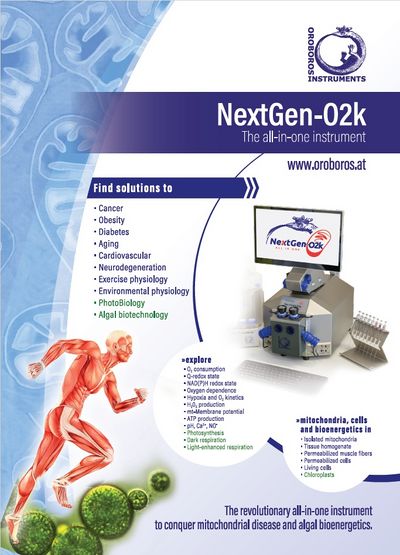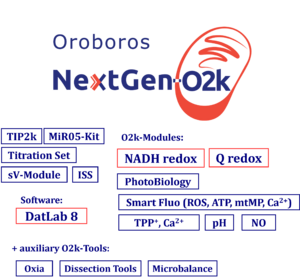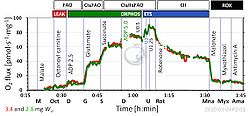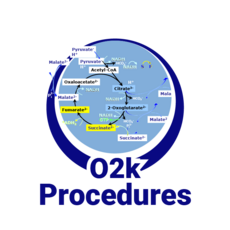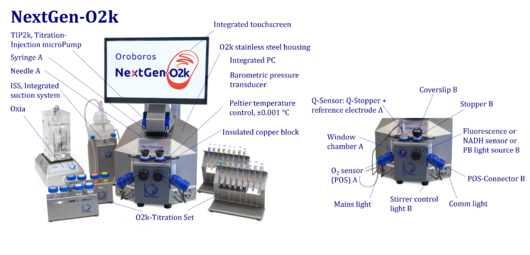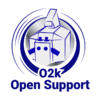 |
Oroboros O2k-technology |
MitoPedia O2k and high-resolution respirometry:
O2k-Open Support
Description
The Oroboros O2k-technology provides modular systems for high-resolution respirometry (HRR) for mitochondria and cell research. Oroboros delivers the O2k-technology for high-resolution respirometry in mitochondria and cell research. The O2k-tecnology allows the measurement of respiration at controlled oxygen levels, combined with redox biology (NADH and CoQ), ROS production, mitochondrial membrane potential, ATP production, Ca2+, or pH. HRR expands to HRPB: High-Resolution PhotoBiology.
Small amounts of biological samples can be used for bioenergetic and OXPHOS analysis, ranging from isolated mitochondria, permeabilized tissues and permeabilized cells to living cells and tissues slices.
The modular O2k-concept is supported by DatLab, with high flexibility for extension by add-on O2k-Modules. All O2k-Modules are supported by the NextGen-O2k. The O2k-Q-Module and the O2k-NADH-Module are exclusively supported by the NextGen-O2k, whereas the O2k (Series-J) provides the basis for all other HRR application but cannot be upgraded to the NextGen-O2k Redox. The globally tested and trusted high-resolution O2k-technology prioritizes both quality and scientific research output in the field of mitochondrial physiology and pathology, extended to PhotoBiology.
Reference: Purchase information, O2k-Top 10
- » The most common applications of the Oroboros O2k-technology
The O2k-technology is used in basic and applied research to study the respiration of tissues, cells and mitochondria. Fairly simple to highly complex, comprehensive experimental protocols can be applied to assess either basal mitochondrial characteristics or obtain diagnostic insight into respiratory pathways. Topically, studies using the O2k range from comparative physiological investigations addressing evolutionary and environmental aspects of mitochondrial metabolism over the energetics related to exercise physiology, nutrition and life style, to aspects of clinical interest such as the impact of metabolic diseases, cancer, or pharmacological interventions.
- The most prominent applications of the O2k-technology
- Studies on exercise physiology;nutrition;life style
- Diagnosis of acquired and genetic mitochondrial diseases
- Diagnosis of myopathies and neuromuscular pathologies
- Studies on cell function and cell death - apoptosis and necrosis
- Measurement of oxidative stress
- Studies on ischemia-reperfusion injury
- Studies on aging and senescence
- Pharmacological tests
- Studies on Diabetes 2
- For more applications, browse through the 4695 O2k-Publications in the MiPMap.
Oroboros O2k-technology: development and distribution
- The O2k-technology is developed by Oroboros Instruments in cooperation with WGT and produced in Austria by WGT.
- High-resolution respirometry: HRR is the basis for combined measurement of respiration with redox biology (NADH and CoQ), ROS production, mitochondrial membrane potential, ATP production, Ca2+, or pH.
- Titration-Injection microPump TIP2k: The O2k-TIP2k combination allows operation with programmable titration regimes, feedback control, and at steady-states, yielding a new flexibility in experimental design by combining the technical advantages of closed and open systems approaches. Automatic titrations for kinetics; feedback-controlled instrumental background tests; respiration in a closed or open system, in aerobic-anaerobic transitions or at steady-state oxygen concentrations, covering the entire physiological oxygen range and the extremes of hypoxia.
- O2k-Modules can be combined with the O2k and NextGen-O2k, and can be added any time to extend the O2k-technology according to instrument comparability and application-specific objectives: Q (Q-redox state), NAD(P)H autofluorescence (NADH-redox state], PhotoBiology (photosynthesis), fluorometry (H2S, ATP, mitochondrial membrane potential, Ca2+), potentiometry (pH, TPP+ or TPMP+ for mitochondrial membrane potential, Ca2+) and amperometry (NO, H2S).
- Auxiliary O2k-Tools provide extended support in the context of high-resolution respirometry: Oxia the O2 regime controller for the O2k; Microbalance, O2k-Dissection Set.
What is an Oxygraph and the O2k?
- »Bioblast links: O2k-technology and HRR - >>>>>>> - Click on [Expand] or [Collapse] - >>>>>>>
- Oroboros Marketplace
- » O2k
- Oroboros Marketplace
- Concept
- » Concentration
- » Coupling-control state
- » Mitochondrial preparations
- » Oxidative phosphorylation
- » Oxygen, dioxygen, O2
- » Oxygen flux
- » Electron-transfer-pathway state
- » Respiration
- » Respirometry; » MitoPedia: Respirometry
- » Substrate-uncoupler-inhibitor titration (SUIT) protocols; » MitoPedia: SUIT
- Concept
Oxygraph: O2
- O2k: The O2k measures oxygen (dioxygen, O2) as a gas dissolved in aqueous solution.
- With the O2k, experimental data are displayed not only of oxygen concentration over time; but real-time transformation of these data allows the experimenter to follow respiration (oxygen consumption, oxygen flux) of biological and biochemical samples while the experiment is still running.
- An Oxygraph is not used to measure oxygen concentration in a tissue, but for high-resolution analysis of respiratory activity of biological or biochemical samples transferred into the experimental chamber.
- Specific substrate-uncoupler-inhibitor titration (SUIT) protocols are applied in studies of cell respiration or mitochondrial activity. In experiments with living cells, different coupling control states can be studied to evaluate ROUTINE respiratory activity, respiration coupled to ATP production, respiratory excess capacity, residual oxygen consumption, and, by extension of conventional protocols, intactness of cell membranes. In mitochondrial preparations such as isolated mitochondria, permeabilized cells and tissue samples, or homogenized tissue, quantitative information is obtained on selected mitochondrial pathways, particularly of the process of oxidative phosphorylation (OXPHOS) in mitochondria and bacteria. Comprehensive OXPHOS analysis leads us beyond the highly informative process of oxygen consumption, when high-resolution respirometry is combined with O2k-MultiSensor modules to simultaneously measure the production of reactive oxygen species or mitochondrial membrane potential, nitric oxide production, acid-base balance or calcium with O2k-FluoRespirometry or ion selective electrodes. In the O2k, these bioenergetic parameters are always evaluated in combination with the measurement of oxygen concentration and respiration.
Oroboros O2k: O2k and high-resolution respirometry
- O2k: The O2k has two experimental chambers (k: Kammern, German for chambers). Why 0.5 to 2 mL?
- Power-O2k: Several O2k units are operated simultaneously (P1, P2, ..) to combine high-resolution respirometry with high-output.
- High-resolution respirometry (HRR) is the result of our long-term expertise in instrumental design, software development, mitochondrial physiology, clinical and pharmacological applications, and world-wide scientific cooperation. The innovative O2k-developments provide a system of highest quality and distinguish HRR as a method and concept.
- HRR is defined on the basis of instrumental features of the O2k. The limit of detection of oxygen flux is as low as 1 pmol O2.s-1.mL-1. Oxygen backdiffusion at zero oxygen is <4 pmol.s-1.mL-1. Oxygen consumption by the polarographic oxygen sensor at air saturation and standard barometric pressure (100 kPa) is 2.7 pmol.s-1.mL-1 (± 0.9 SD; 114 test runs at 37 °C). These highly standardized instrumental background fluxes are a linear function of oxygen concentration, which is used for automatic background correction of oxygen flux (DatLab). Typical exponential time constants of the oxygen sensors are <4 s, used for dynamic corrections in kinetic studies. Signal noise at zero oxygen concentration is <0.05 µM O2.
- The Oroboros O2k is the unique state-of-the-art instrument for HRR - where high-resolution counts:
- with small amounts of cells or tissue,
- at low respiratory activities,
- multiple substrate-uncoupler-inhibitor titrations (SUIT protocols) with resolution of changes in oxygen flux over prolonged incubation times,
- flexibility of O2k-MultiSensor applications,
- fast transitions at low oxygen levels,
- stability and quality control.
- Today, such high resolution meets rapidly increasing demands, reflected by the increasing number and high level of O2k-Publications. Applications of the O2k in leading O2k-Network Labs are the driving forces for a rapid advancement of mitochondrial physiology. Open access to the O2k-Manual is an integral part of the concept of Oroboros Instruments on Gentle Science and Scientific Social Responsibility. With sharing of O2k-Procedures and implementation of quality control, the study of mitochondrial and cell respiration emerges as a quantitative science. Thus high-resolution respirometry provides the foundation for comparative mitochondrial physiology, biomedical research, translation into clinical applications, establishing quantitative functional mitochondrial diagnosis.
- Sole source information: pdf
- Frequently Asked Questions
- The Oroboros O2k sets a world-wide standard in high-resolution respirometry - for mitochondrial studies in cell physiology and pathology.
- In contrast to merely offering an oxygen measuring device, the Oroboros O2k is integrated into a systems approach to high-resolution respirometry. This spans from experimental tools which are invaluable in the lab (e.g. ISS), or little aids that are crucial for tissue preparation (forceps), mitochondrial respiration medium (MiR05-Kit), substrate-uncoupler-inhibitor titration protocols, and the unique O2k-Workshops.
MitoPedia O2k and high-resolution respirometry:
O2k hardware,
O2k-Open Support,
O2k-Respirometry,
O2k-FluoRespirometry

